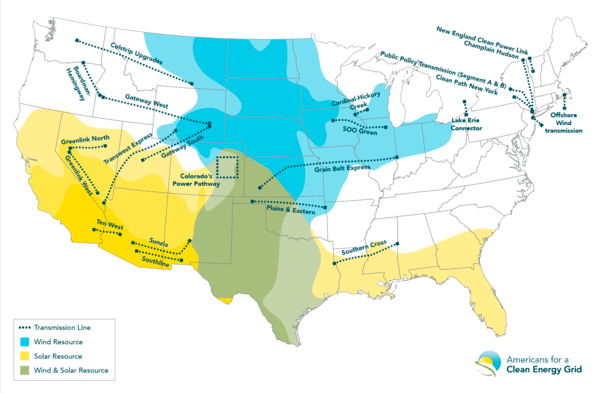New Report Identifies 22 Shovel Ready Regional and Interregional Transmission Projects
A new report released today identifies 22 shovel ready, high-voltage transmission projects across the country that, if constructed, would create approximately 1,240,000 American jobs and lead to 60,000 megawatts (MW) of new renewable energy capacity, increasing American’s wind and solar generation by nearly 50 percent. The report, Transmission Projects Ready to Go: Plugging into America’s Untapped Renewable Resources, produced by Americans for a Clean Energy Grid (ACEG) as part of the Macro Grid Initiative, outlines how these projects could begin construction soon if more workable transmission policies are enacted.
These regional and interregional transmission lines would not only bring quality wind and solar resources to areas with high demand but also increase economic development and grid resiliency as well as provide cost-savings for consumers.
“Transmission may be the purest form of “infrastructure” in a modern economy. The backbone transmission network supports all types of electricity production, and electricity supports every aspect of modern life, including increasingly transportation and all forms of commerce,” says Rob Gramlich, Executive Director of Americans for a Clean Energy Grid. “Transmission is finally in the conversation about infrastructure and for good reason. We do not have a functioning way to recover costs of the large-scale interregional transmission that we need, and it is an appropriate subject for infrastructure legislation. These projects can put people to work in the near term.”
Currently, construction on these large projects has stalled, preventing many of the benefits of expanded transmission from being realized. In order for construction on these lines to commence, proper transmission policies relating to how long-range transmission is planned, paid for, and permitted must be passed. The report recommends the following policy changes:
- Passage of a transmission investment tax credit;
- Direct investment in new transmission lines, with the federal government serving as an “anchor tenant” customer;
- FERC using its authority to reform transmission planning and cost allocation; and
- Streamlining and expediting the permitting process.
“Just like the federal interstate highway system helped drive the growth of the American economy in the last half of the 20th Century, an interstate electricity transmission system is needed to power the American economy into the 21st Century,” says Michael Goggin, lead author and Vice President of Grid Strategies, LLC. “Over 1.2 million jobs can be created by building transmission lines to access untapped renewable resources, bringing sorely needed jobs and economic development to America’s rural areas. A stronger grid is also the best solution for preventing power outages, like the tragic events that affected Texas and other parts of the Central U.S. in February.”
“Expanding and upgrading our outdated transmission system, a central tenet of President Biden’s new American Jobs Plan, is an incredible economic opportunity for our nation,” says Gregory Wetstone, President and CEO of the American Council on Renewable Energy (ACORE). “With smart transmission policies in place, we can put Americans back to work in good-paying jobs building a more reliable, efficient and carbon-free grid.”
The 22 proposed projects are described in detail in the report and depicted in the map below.

Image: Americans for a Clean Energy Grid
To read the new report, Transmission Projects Ready to Go: Plugging into America’s Untapped Renewable Resources, click here.
This report was commissioned by Americans for a Clean Energy Grid with support from the Macro Grid Initiative, a project of the American Council on Renewable Energy.
Additional Statement:
Liza Reed, Research Manager, Low-Carbon Technology Policy, Niskanen Center: “Interstate transmission, like most of the 22 projects identified in the report, will provide the resilience and reliability that the grid needs as we integrate diverse generation resources and face changing weather patterns. These kinds of lines face the most regulatory barriers, and the most financial uncertainty, but have the potential to provide wide ranging benefits. Nearly half the projects identified use high voltage direct current, a crucial technology for strengthening our electricity system, sharing power across regions, and recovering from blackouts. Streamlining siting and permitting process, would speed these and future projects needed for a clean energy grid. Financial incentives to reduce project risk is also critical to meet the growing need for transmission capacity.”
- Source:
- Americans for a Clean Energy Grid
- Author:
- Press Office
- Link:
- cleanenergygrid.org/...
- Keywords:
- ACEG, USA, transmission grid, infrastructure, renewable energy, economy, grid resilience, project, report, jobs, MW, Clean Energy Grid

























